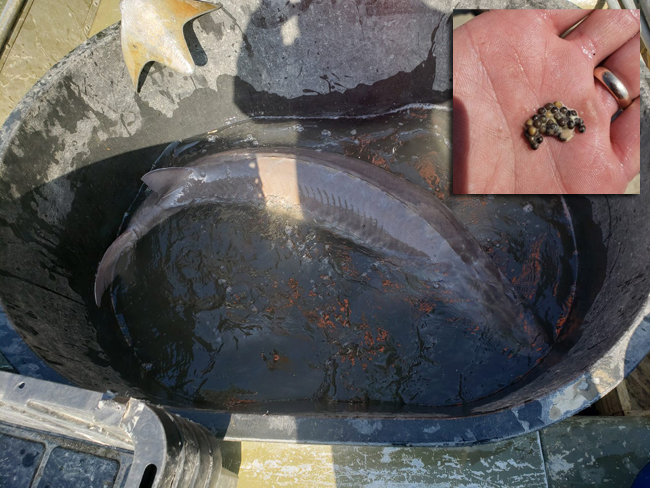
A spawning female lake sturgeon is found in the Genesee River. Inset: Sturgeon Eggs. Credit: USGS/Marc Chalupicki
— Published in the Monroe County Post
Canandaigua, NY, July 23, 2021 - The New York State Department of Environmental Conservation announced a milestone in the restoration of the Genesee River after collecting a spawning female lake sturgeon for the first time in more than 50 years.
Dawn Dittman, a research ecologist with the U.S. Geological Survey’s Great Lakes Science Center, and a field crew from the Tunison Laboratory of Aquatic Science netted the 61-inch, nearly 70-pound female lake sturgeon earlier this summer.
DEC started stocking lake sturgeon in the lower Genesee River in 2003 as part of the state’s efforts to support the species’ recovery.
“Working with our partners, DEC’s investments and efforts to stock and clean up the Genesee watershed have paid off for lake sturgeon in the Genesee River,” Commissioner Basil Seggos said. “This sturgeon thrived in the Genesee as a stocked juvenile and has finally reached maturity to hopefully produce another generation. We appreciate the work of all our federal partners, Monroe County, Seneca Park Zoo, New York Sea Grant and others improving the Genesee River ecosystem and increasing public awareness of the river’s ongoing restoration.”
The discovery of the spawning lake sturgeon in lower section of the Genesee is significant, as the area is part of the Rochester Embayment Area of Concern. DEC works with regulatory partners at the USGS, U.S. Fish and Wildlife Service, U.S. Environmental Protection Agency and Monroe County Department of Health to improve water quality and restore habitat in the Rochester Embayment AOC. Seneca Park Zoo and New York Sea Grant help educate the public about lake sturgeon and the Genesee River.
Dittman has worked with DEC to collect scientific data on lake sturgeon since the stocking program was created nearly 30 years ago.
“I am thrilled to report this milestone in the long-term restoration of lake sturgeon to the Genesee River,” Dittman said. “The finding validates scientists’ expectation that the first spawning would occur when stocked female sturgeons reached 17 or 18 years old.”
DEC asks the angling public to support their recovery by releasing accidentally hooked sturgeon immediately. The heat and stress of spawning make lake sturgeon more vulnerable to incidental mortality from angling at this time of year. DEC depends on anglers to remove the hook while the fish is in the water before moving to a different location or using a different angling technique.
More Info: New York Sea Grant
New York Sea Grant (NYSG), a cooperative program of Cornell University
and the State University of New York (SUNY), is one of 34 university-based
programs under the National Oceanic and Atmospheric Administration’s
National Sea Grant College Program.
Since 1971, NYSG has represented a statewide network of integrated
research, education and extension services promoting coastal community
economic vitality, environmental sustainability and citizen awareness
and understanding about the State’s marine and Great Lakes resources.
Through NYSG’s efforts, the combined talents of university scientists
and extension specialists help develop and transfer science-based
information to many coastal user groups—businesses and industries,
federal, state and local government decision-makers and agency managers,
educators, the media and the interested public.
The program maintains Great Lakes offices at Cornell University, SUNY
Buffalo, SUNY Oswego and the Wayne County Cooperative Extension office
in Newark. In the State's marine waters, NYSG has offices at Stony Brook
University in Long Island, Brooklyn College and Cornell Cooperative
Extension in NYC and Kingston in the Hudson Valley.
For updates on Sea Grant activities: www.nyseagrant.org has RSS, Facebook, Twitter, Instagram, and YouTube links. NYSG offers a free e-list sign up via www.nyseagrant.org/nycoastlines for its flagship publication, NY Coastlines/Currents, which is published quarterly.